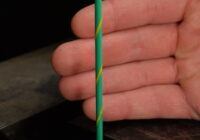
May 5, 2021
Installing THHN cable in cold weather
Experiencing cold weather can cause problems for your skin, your heating bills — and your cable installations. In particular, thermoplastic, high-heat resistant, nylon-coated (THHN) cables can be difficult to work with in the cold.
THHN cables are versatile and capable, but they’re designed for high-heat applications, not cold ones. They’re vulnerable to deterioration in cold weather, so you need to know a few things about your application before you install a THHN cable in the dead of winter.
What Is THHN Wire and Cable?
THHN wire is named after its characteristics:
- Thermoplastic: THHN wire has thermoplastic insulation, often made of materials like polyvinyl chloride (PVC) or polyethylene (PE).
- High-heat resistance: These cables are rated to withstand high heat, up to 194 degrees Fahrenheit or 90 degrees Celsius.
- Nylon coating: THHN wire has a nylon jacket to resist abrasions, cuts and physical threats like chemicals, oil and water.
THHN is a versatile cable, available in a range of colors, sizes and strengths. While it does not fall under any specific application category, it is mostly used under the hook-up wire class. THHN wire is generally used indoors and is popular as building wire because of its voltage capacities and affordability. It can also be used in some outdoor applications if it is safely installed in a conduit.
Since it is made from thermoplastic material, you can heat THHN wire many times to change its shape. But there is a limit to the number of times this wire can stand heating and cooling. It has its lower and higher temperature limits and if the temperature changes cross this range, this wire can become unstable. The temperature range varies by manufacturer.
When the THHN cable comes with a high-heat rating, it means that this wire can be used in high-temperature scenarios. These wires come with various specifications, which determine the specific applications where these can be used. Be sure to read your cable’s documentation carefully to make sure it is suited for your project.
How Do Cold Temperatures Affect Cable?
Below their rated temperatures, cables become stressed, get brittle and lose flexibility. This makes them harder to pull and more susceptible to damage. PVC jackets are particularly prone to stiffening in cold temperatures and will crack if bent too far. Some insulation materials, like cross-linked polyethylene (XLPE), can maintain flexibility in colder environments.
Most cables will be rated for a specific installation temperature, which is higher than the minimum operating temperature to allow for more stress during installation.
Tips for Installing THHN Cable in Cold Weather
When it comes to installing THHN cable in the cold weather, there are some simple guidelines that you should follow:
- Keep this cable indoors, and not in the outdoor harsh environment. Generally, a temperature of 65 degrees Fahrenheit works well.
- If keeping the cable indoors is not possible, bring it inside for at least 24 hours, before you install it.
- If the outside temperature is below 14 degrees Fahrenheit, then do not install the THHN cable.
- While installing the cable, take care that it is not dropped on the floor, as these impacts can cause cracks in the stiff cable material.
- Make sure you do not bend the cable too much, because it can cause the cold and stiff cable to break.
Once you have installed it, this cable will work properly in environments with temperatures higher than 14 degrees Fahrenheit.
How WesBell Electronics Can Help
Here at WesBell Electronics, we are well-versed in cables and what it takes to install them correctly. With our vast selection of quality cables, we can help you find the right one for your next project, whether it is a THHN cable or something different.
Pulling wire in chilly weather is not ideal, but with some preparation, it is achievable. If you have any questions about your choice of cable or performing an installation in less-than-optimal temperatures, please reach out to our experienced team.









